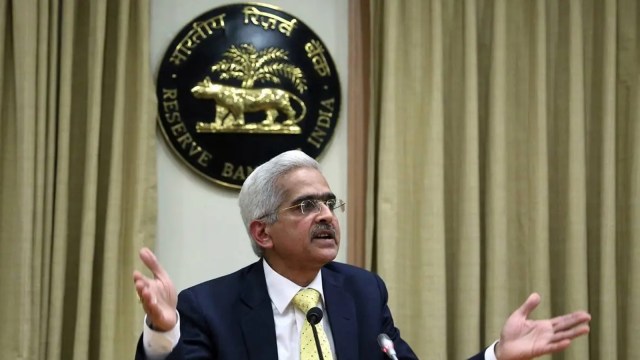RBI leaves repo rate unchanged, food inflation uncertainty persists
The status quo in the repo rate will provide relief to home, vehicle, personal and other loan borrowers as their equated monthly instalment (EMI) will not increase.
 RBI Governor Shaktikanta Das
RBI Governor Shaktikanta Das The six-member Monetary Policy Committee (MPC) of the Reserve Bank of India (RBI) Thursday left the repo rate — the rate at which the RBI lends to banks — unchanged at 6.5 per cent for the sixth time in a row as uncertainty over food inflation continues to pose a threat to inflation.
The RBI projected real GDP growth at 7 per cent and consumer-price based inflation (CPI) at 4.5 per cent for FY2025. Its growth estimate for FY2025 is lower than the 7.3 per cent projected by the National Statistical Office (NSO) for the ongoing fiscal. The government, in the Interim Budget for 2024-25, said the nominal GDP – without excluding the pace of inflation – is likely to grow at 10.5 per cent.
Announcing the policy, RBI Governor Shaktikanta Das said, “Taking into account this growth-inflation dynamics and the fact that transmission of the cumulative 250 bps (basis points) policy rate hike is still underway, the MPC decided to keep the policy repo rate unchanged at 6.5 per cent. The MPC will carefully monitor any signs of generalisation of food price pressures which can fritter away the gains in the easing of core inflation.”
The decision to keep the repo rate steady at 6.5 per cent was taken in a 5:1 majority, with one external member of MPC, Jayanth Varma, voting for a 25 basis points (bps) reduction in the repo rate. One basis point is one-hundredth of a percentage point.
The status quo in the repo rate will provide relief to home, vehicle, personal and other loan borrowers as their equated monthly instalment (EMI) will not increase.
Das said the monetary policy will continue to be disinflationary to align inflation to the target of 4 per cent on a durable basis. The government has mandated the RBI to keep inflation in the 2-6 per cent band.
Retail inflation, after moderating to 4.9 per cent in October, rose to 5.7 per cent in December 2023, mainly due to food inflation, mostly vegetables.
“The uncertainties in food prices, however, continue to impinge on the headline inflation trajectory,” Das said.
The MPC also decided by a majority of 5 out of 6 members to remain focused on the withdrawal of accommodation to ensure that inflation progressively aligns to the target, while supporting growth.
“Our stance of withdrawal of accommodation should be seen in the context of incomplete transmission and inflation ruling above the target of 4 per cent and our efforts to bring it back to the target on a durable basis,” Das said.
The real GDP growth for FY25 is projected at 7 per cent, with Q1 at 7.2 per cent; Q2 at 6.8 per cent; Q3 at 7 per cent; and Q4 at 6.9 per cent.
He said domestic economic activity continues to remain strong and the momentum is expected to continue in the next financial year (2024-25).
“At the current juncture, India’s potential growth is propelled by structural drivers like improving physical infrastructure; development of world class digital and payments technology; ease of doing business; enhanced labour force participation; and improved quality of fiscal spending,” he said.
The RBI’s multi-pronged, proactive, and calibrated policies on the monetary, regulatory and supervisory fronts have worked well to maintain and strengthen macroeconomic and financial stability, he said.
For FY24, the RBI retained CPI inflation projection at 5.4 per cent. The inflation expectation for Q4 FY24 has, however, been revised lower to 5 per cent from 5.2 per cent projected in the previous policy.
Retail inflation for 2024-25 is projected at 4.5 per cent with Q1 at 5 per cent; Q2 at 4 per cent; Q3 at 4.6 per cent; and Q4 at 4.7 per cent, the RBI said.
Das said the RBI will actively manage liquidity which has turned into deficit from September 2023 after a gap of four-and-half years.
During December-January, the RBI pro-actively injected liquidity through both the main and the fine-tuning repo operations to ease liquidity tightness in the system, he said. The banking system liquidity turned deficit to a record high of Rs 3.46 lakh crore on January 24.
With government spending picking up and augmenting system level liquidity, the RBI undertook six fine-tuning variable rate reverse repo (VRRR) auctions during February 2-7, 2024 to absorb surplus liquidity.
“We will deploy an appropriate mix of instruments to modulate both frictional and durable liquidity so as to ensure that money market interest rates evolve in an orderly manner and financial stability is maintained,” Das said.
Commenting on the policy, Bank of Baroda’s Chief Economist Madan Sabnavis said that the RBI has affirmed its confidence in the growth story of India and projected GDP to increase by 7 per cent next year. With growth on target, the concentration will be on bringing down inflation to the target of 4 per cent.
Based on the quarterly projections of inflation for next year, a rate cut is possible only in Q2 FY25 when the forecast of inflation is 4 per cent. However, inflation is expected to increase in Q3 and Q4 to above 4.5 per cent and, hence, there will be a nuanced approach by the RBI, he said.
“We do get a sense that the RBI will have to be convinced that inflation is stable and on the downward path before it embarks on either changing stance or the repo rate,” Sabnavis said.
- 01
- 02
- 03
- 04
- 05































